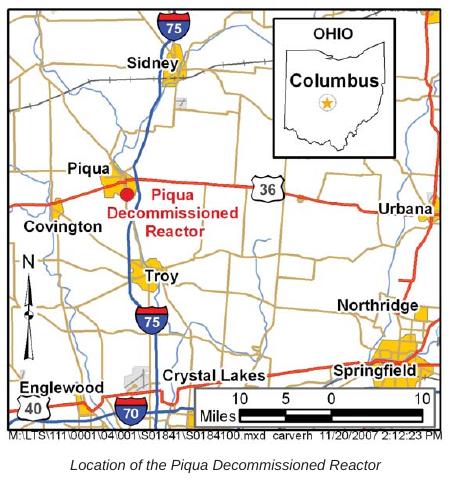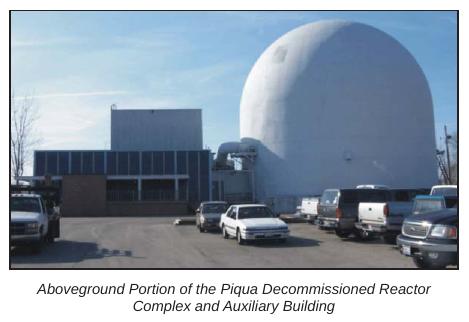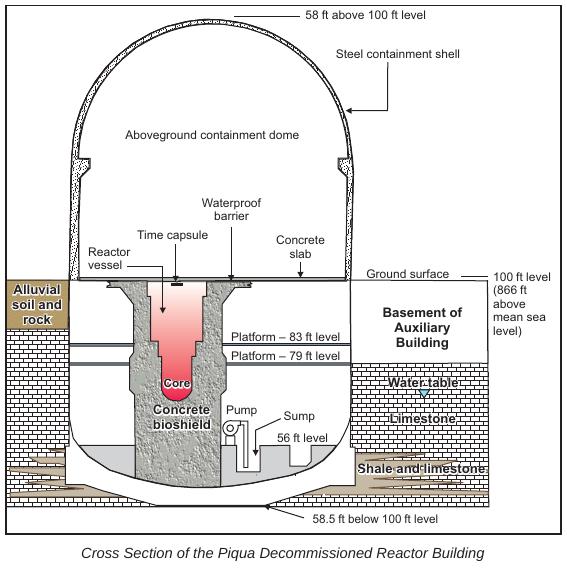Piqua Organic Moderated Reactor
Home / Areas of Practice / Energy Employees Occupational Illness Compensation Program Act (EEOICPA) / EEOICPA: SEC Sites By State / Piqua Organic Moderated Reactor
Also Known As: Piqua Nuclear Power Facility, PNPF
State: Ohio
Location: Piqua
Time Period: 1963-1969
Facility Type: Department of Energy
Facility Description
From 1963 to 1966, the Piqua Nuclear Power Facility was operated as a demonstration project by the City of Piqua. The facility contained a 45.5-megawatt (thermal) organically cooled and moderated reactor. In 1966, the AEC discontinued facility operations and terminated its contract with the city. The AEC dismantled and decommissioned the reactor between 1967 and 1969. The reactor fuel coolant and most of the radioactive materials were removed from the site.
Listing
Piqua Organic Moderated Reactor is listed as a Department of Energy (DOE) site under the EEOICPA.
Special Exposure Cohort (SEC) Classes
All employees of the Department of Energy, its predecessor agencies, and its contractors and subcontractors who worked at the Piqua Organic Moderated Reactor site during the covered period from May 2, 1966 through February 28, 1969, for a number of work days aggregating at least 250 work days, occurring either solely under this employment or in combination with work days within the parameters established for one or more other classes of employees in the Special Exposure Cohort
Classes Not Added to the SEC
All employees of the Department of Energy, its predecessor agencies, and their contractors and subcontractors who worked in any location at the Piqua Organic Moderated Reactor during the operational period from January 1, 1963 through May 1, 1966
Petitions Qualified for Evaluation
Location: Piqua, Ohio
Job Titles and/or Job Duties: All employees associated with reactor activities who worked within and around the Reactor Dome
Period of Employment: January 1, 1963 through December 31, 1966
Compensation
As of 08/23/2015, the total compensation paid under Parts B and E of the EEOICPA, including medical compensation, for workers suffering from the effects of having worked at the Piqua Organic Moderated Reactor is $2,649,060.
Piqua Organic Moderated Reactor Workers
If you or your parent worked at this or any other DOE or AWE facility and became ill, you may be entitled to compensation of up to $400K plus medical benefits from the US Department of Labor. Call EEOICPA Counsel Hugh Stephens at 1-855-EEOICPA (336-4272) or fill out the form to the right, whether or not you have already filed a claim and even if your claim has been accepted or denied.
We can help with all OWCP (Federal Workers Compensation) claims, impairments, wage loss and health care. 2495 Main Street, Suite 442 Buffalo, NY.
*Site Description and History
The Piqua, Ohio, Decommissioned Reactor site is located in southwestern Ohio in the city of Piqua on the east bank of the Great Miami River, about 30 miles north of Dayton. The site is approximately 900 feet southeast of the Piqua municipal power station and 150 feet north of the city sewage treatment plant. A limestone quarry frames the north and east sides of the reactor site. The decommissioned reactor is about 120 feet from the Great Miami River.
The first 45.5 megawatt, organically cooled and moderated, thermal reactor was built by the U.S. Atomic Energy Commission (AEC)—predecessor agency to the U.S. Department of Energy (DOE)—as a demonstration project. The prototype used a commercially available mixture of aromatic hydrocarbons called terphenyls to cool the reactor. The 27-foot-tall vessel was made of low-carbon steel and its 7.6-foot-diameter interior had an average wall thickness of 2 inches. The reactor produced 150,000 pounds-per-hour of 550 °F superheated steam, at a pressure of 450 pounds per square inch. The steam was pumped to turbo-generators in the Piqua municipal power plant to augment the city’s power supply, through footbridge pipes across the Great Miami River.
AEC contracted the City of Piqua to operate and maintain the facility, beginning in June 1963. The reactor was shut down in January 1966 because of economic and technical considerations. AEC terminated its contract with the City of Piqua in 1967 and dismantling and decommissioning activities began that year. Cleanup was completed in 1969 and the reactor vessel was buried in place.
Construction of water retarding dams and basins in 1921 greatly reduced river flooding throughout the Great Miami River Basin. One of the dams, constructed 4 miles upstream of Piqua, was designed to work with levees and river channel improvements to permit a maximum river flow of 80,000 cubic feet per second at the site. Since the dams were constructed, the highest river flow at Piqua was 22,000 cubic feet per second in 1929 and 1933. The river elevation during that flow was about 9 feet below the main floor level of the reactor building.



Videos
An educational description of PNPF can be seen below:
DOCUMENTS
NIOSH SEC Petition Evaluation Reports
Petition 126 (May 2, 1966 to Feb 28, 1969)
SEC Petition Evaluation Report, Petition SEC-00126, Rev #: 1
Report Submittal Date: September 14, 2009
SEC Petition Evaluation Report, Petition SEC-00126, Rev #: 0
Report Submittal Date: April 27, 2009
SC&A
Share this:
EEOICPA CLAIMS
If you or your parent worked any of the DOE or AWE facilities listed on this website and became ill, you may be entitled to compensation of up to $400K plus medical benefits from the US Department of Labor.
Call EEOICPA Counsel Hugh Stephens at 1-800-548-4494, email hstephens@stephensstephens.com, or fill out the form below whether or not you have already filed a claim and even if your claim has been accepted or denied.
Contact Us
"*" indicates required fields
*note: Submission of this form does not establish an attorney-client privilege.
Contact Us
Address:
2495 Main Street, Suite 442
Buffalo, New York 14214
Phone:
(716) 852-7590
Fax:
(716) 852-7599
After Hours:
(716) 208-3525
Email Us:
R. William Stephens, Esq.
R. Hugh Stephens, Esq.
Lisa P. Neff, Esq.

